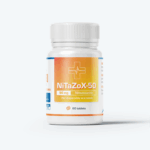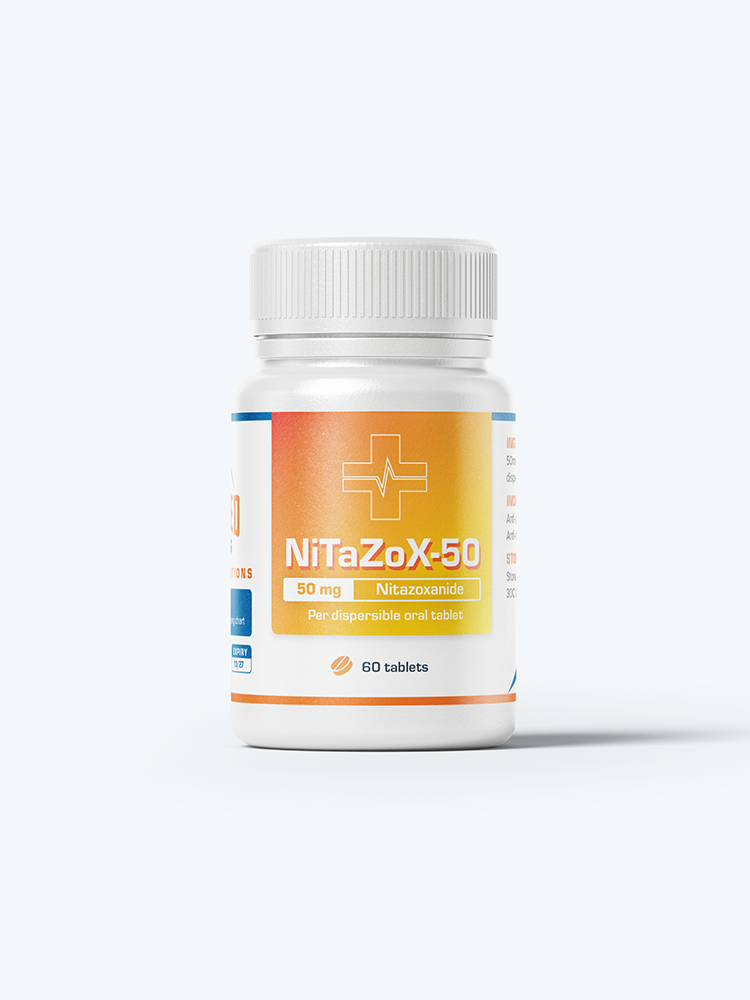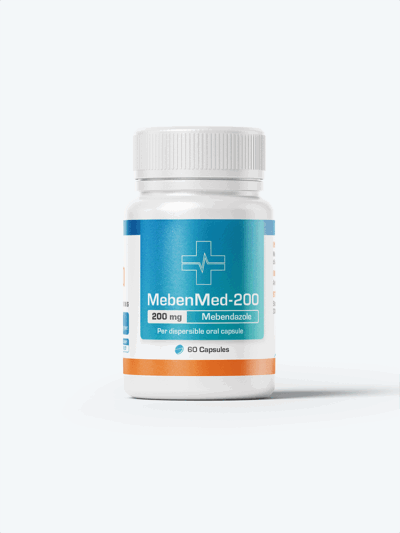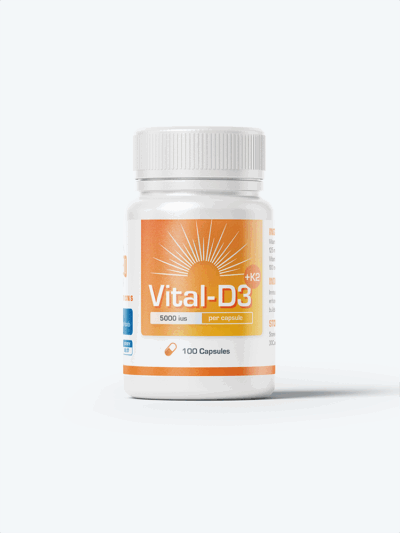
NiTaZoX-50, 20 Pack
NiTaZoX-50, 20 Pack
Anti-Cancer, Anti-Parasitic, HealingOriginal price was: $2,220.00.$1,660.00Current price is: $1,660.00.
60 Nitazoxanide Tablets Composition –
50mg Nitazoxanide per dispersible oral tablet
Indications – Anti-parasitic, Anti-Viral, Anti-cancer, Anti-bacterial
Dosage – Use as directed
PLEASE NOTE: the administration of NiTaZoX-50 with a high-fat meal greatly increases its bioavailability. Consume your dose 5-10 mins prior to a meal
Elevated Healing presents a very interesting compound for sale known as
Nitazoxanide. NiTaZoX-50, Nitazoxanide, is an orally active drug with
significant patient experience including more than 75 million adults and
children.
NiTaZoX-50 is a broad-spectrum anti-infective drug that adversely
affects viability, growth, and proliferation of a range of extracellular
and intracellular protozoan, helminths, anaerobic and microaerophilic
bacteria, and viruses. Nitazoxanide, is an FDA approved antiparasitic
drug primarily used for treating protozoal infections like giardiasis
and cryptosporidiosis, and it has emerged as a promising repurposed
agent for cancer therapy based on extensive preclinical research.
Pioneered by Dr Simon Yu as early as 2003, Nitazoxanide shows great
promise as an anti-cancer agent.
-
Description
Nitazoxanide Overview
A number of clinical trials have suggested that it can be used in cryptosporidiosis, hepatitis B, hepatitis C, cancers, viral infections, and helicobacter infection. Additional recent research has proposed its beneficial effect in treating the symptoms of coronavirus infection.
Although nitazoxanide was initially designed as an anti-microbial drug, significantly anti-cancer properties have also been observed. Experiments in various human cancer cell lines and tumor models have validated the antitumor efficacy of nitazoxanide. Nitazoxanide appears to interfere with crucial metabolic and pro-death signaling such as drug detoxification, unfolded protein response (UPR), autophagy, anti-cytokine activities, and c-Myc inhibition.
Anti-Cancer Mechanisms
Colon Cancer Cells
Treating colon cancer cells with NiTaZoX-50 leads to inhibition of cell growth, nuclear condensation, DNA fragmentation, and apoptosis induction, with glutathione-S-transferase P1 (GSTP1) identified as its primary target. It activates the AMPK pathway and downregulates c-Myc, mTOR, and WNT signaling in colon cancer.
Broad-Spectrum Activity
NiTaZoX-50 exhibits anti-tumor activity through multiple molecular targets, often at clinically achievable concentrations (5–10 µM plasma levels). Mechanisms include:
-
Wnt/β-Catenin Inhibition: Promotes β-catenin citrullination and degradation, reducing proliferation and MDR in colorectal cancer (CRC).
-
Proteasome Inhibition: Unique binding to the β5 subunit of the 20S proteasome, causing cell cycle arrest and apoptosis.
-
Mitochondrial Dysfunction: Acts as a mitochondrial uncoupler, disrupting ATP production and increasing ROS, selectively targeting resistant hypoxic tumor cells.
-
Autophagy & Apoptosis Modulation: Blocks late-stage autophagy, impairs mitophagy, upregulates pro-apoptotic proteins, and downregulates anti-apoptotic BCL-2.
-
Additional Pathways: Suppresses c-Myc, activates AMPK, inhibits HDAC1, enhances ferroptosis/apoptosis, and modulates TGF-β signaling.
Specific Preclinical Evidence
-
Colon Cancer: Inhibits Wnt/β-catenin-dependent proliferation; reduces tumor growth in vivo.
-
Ovarian Cancer: Inhibits proliferation in A2780 and SKOV3 cell lines; oral administration reduces tumor growth in xenograft mice with minimal toxicity.
-
Prostate Cancer: Suppresses acetylated KLF5-induced bone metastasis via TGF-β axis.
-
Glioblastoma: Inhibits late-stage autophagy, upregulates ING1, induces cell cycle arrest, and radiosensitizes quiescent tumor cells.
-
Anaplastic Thyroid Cancer (ATC): Synergizes with auranofin by activating ferroptosis and apoptosis pathways.
-
Other Cancers: Studied in breast cancer, hepatocellular carcinoma (HCC), and precision therapies targeting Wnt-driven tumors.
References
-
Di Domenico, C. G., et al. (2014). A functional perspective of nitazoxanide as a potential anticancer drug. Life Sciences, 135, 1–7.
-
El-Khoueiry, A. B., et al. (2021). Antitumor activity of nitazoxanide against colon cancers. Frontiers in Pharmacology, 12, 650942.
-
Wang, Y., et al. (2024). Anti-cancer effects of nitazoxanide in epithelial ovarian cancer. Chemico-Biological Interactions, 399, 111322.
-
Hawsawi, O., et al. (2023). Nitazoxanide inhibits acetylated KLF5-induced bone metastasis. BMC Medicine, 21, 63.
-
Di Domenico, C. G., et al. (2022). Selective radiosensitization by nitazoxanide of quiescent colon cancer cells. Oncology Letters, 23(5), 132.
-
Li, Y., et al. (2025). Combination nitazoxanide and auranofin in anaplastic thyroid cancer. Cancer Letters, 592, 216560.
-
Pfab, F., et al. (2022). Molecular targets and pathways in hepatocellular carcinoma. Frontiers in Pharmacology, 13, 968148.
-
Pfab, C., et al. (2021). Repurposing of antimicrobial agents for cancer therapy. Cancers, 13(13), 3193.
-
Bharti, C., et al. (2021). Role of nitazoxanide as a repurposed drug. Drugs Today, 57(7), 455–473.
-
Di Santo, N., & Ehrisman, J. (2013). Potential Role of Nitazoxanide in Ovarian Cancer Treatment. Cancers, 5(3), 1163–1176.
-
Nicola Di Santo, Jessie Ehrisman. Nitazoxanide as a potential anticancer drug. Mutation Research, 768, 2014.
-
Di Domenico, C. G., et al. (2022). Nitazoxanide induces cancer cell death via proteasome targeting. Biochemical and Biophysical Research Communications, 590, 1–7.
-
Müller, J., et al. (2008). Thiazolides inhibit growth via GSTP1 in colon cancer. International Journal of Cancer, 123(8), 1797–1806.
-
U.S. National Library of Medicine. ClinicalTrials.gov: Nitazoxanide in colorectal cancer (NCT06049901).
-
Anderson, V. R., & Curran, M. P. (2007). Nitazoxanide in gastrointestinal infections. Drugs, 67(13), 1947–1967.
-
Parvez, M. K. (2016). Nitazoxanide: A broad spectrum antimicrobial. J Adv Pharm Tech Res, 7(3), 89–93.
-
Rossignol, J. F. (2014). Nitazoxanide: A first-in-class antiviral agent. Antiviral Research, 110, 94–103.
-
Haffizulla, J., et al. (2014). Nitazoxanide in influenza: randomized trial. The Lancet Infectious Diseases, 14(7), 609–618.
-
U.S. FDA. Nitazoxanide tablets: Label (2021).
-
MedlinePlus. Nitazoxanide drug information.
-
Fox, L. M., & Saravolatz, L. D. (2005). Nitazoxanide antiparasitic review. Clinical Infectious Diseases, 40(8), 1173–1180.
-
Shakya, A., et al. (2018). Update on nitazoxanide as a chemotherapeutic agent. Curr Drug Discov Technol, 15(3), 201–213.
-
White, A. C., Jr. (2004). Nitazoxanide: broad spectrum antiparasitic. Expert Review of Anti-Infective Therapy, 2(1), 43–49.






